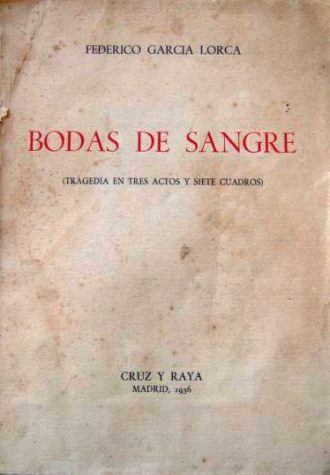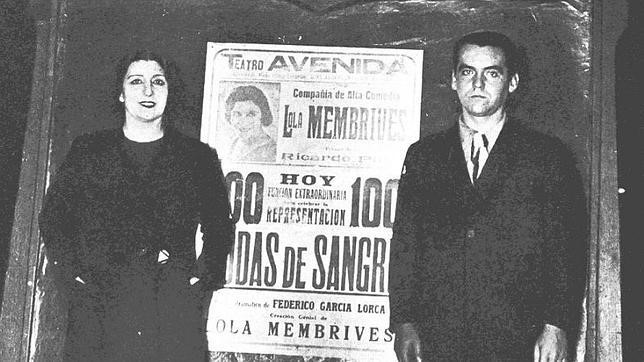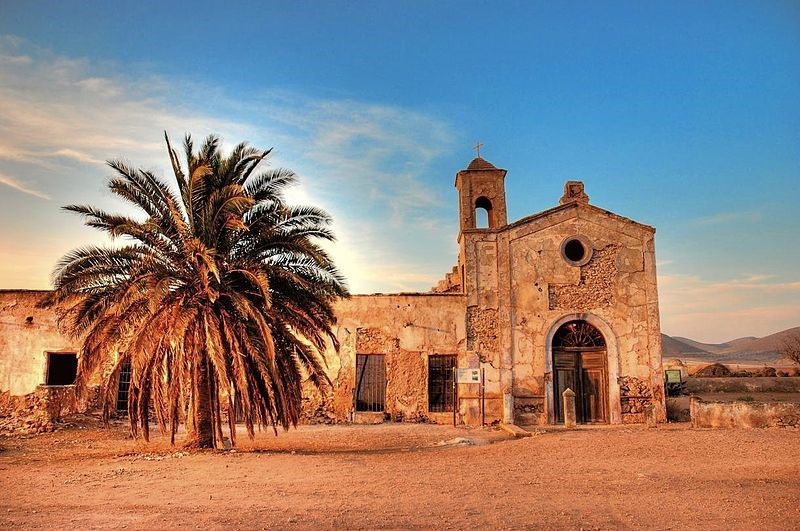
Bodas de sangre (Blood Wedding. Tragedy in three acts and seven scenes) narrates, in verse and prose, the story of a peasant wedding. The Bride, one of the main characters, although about to marry, is still in love with Leonardo Felix (the only character in the drama who bears his own name, married and in love with her for years). Leonardo’s family is to blame for the death of the father and brother of the Bridegroom. His mother does not forget. On the wedding day, the Bride and Leonardo run away. The Mother and the Bridegroom pursue them: honor is recovered by washing away the shame even with a knife. Leonardo and the Bridegroom kill each other. “Neighbors: with a knife,” says the mother while the others, kneeling on the ground cry. That is how the tragedy ends.
On March 8, 1933, six months after the last reading, Josefina Díaz de Artiaga’s company premiered the play at the Teatro Beatriz. It was directed by Eduardo Marquina and Federico García Lorca himself. His brother Francisco, present at the rehearsals and the premiere, recalls those days in Federico and his world: “It represented Federico’s first success as a playwright”. But total success had to wait for the premiere in Buenos Aires. The actress Lola Membrives takes it to the stage at the Maipo theater in Buenos Aires on July 29 of the same year. The overwhelming success led it to be staged again at the Avenida theater, in the same city. And Lorca went to witness the triumph. Buenos Aires, Montevideo, Rosario and Córdoba. The unanimity of the critics is notable: “Rarely have the Buenos Aires theater chroniclers been so unanimous in extolling the merits of a foreign novelty”. The play was revived in Buenos Aires (it reached 150 performances), where Lorca stayed from October 1933 until the following year. However, the revival in Madrid by Membrives does not achieve the same success, which also occurred when the play was staged shortly before in New York in its English version.
First performance of Blood wedding by Margarita Xirgu in Barcelona (November 22, 1935, Principal Palace). That year Federico García Lorca declares: “This is a real premiere. Now you will see the play for the first time. Now it is performed in its entirety. Imagine that they have already placed on the posters the real name with which he had baptized the work Tragedy“. Now the triumph is total. It was directed by Cipriano Rivas Cherif and Lorca himself. The painter José Caballero designed the sets and Lorca chose and performed some of the music. The critics were on his side. María Luz Morales (La Vanguardia) writes: “It is not only the premiere of Blood wedding in Barcelona, but also the quality of this performance with the collaboration of García Lorca and Rivas Cherif, and the interpretation of the mother (sic) by Margarita Xirgu, which also deserve premiere honors”. Blood wedding has triumphed as Lorca wanted, as a tragedy. And the author is already an internationally acclaimed artist.

It was published during the author’s lifetime by Ediciones del Árbol, in the magazine Cruz y Raya (directed by José Bergamín and with a colophon dated January 31, 1936). The text does not include the retouching of the 1936 Barcelona version and contains some copying errors. Lorca gave the signed copy of Blood wedding to Eduardo Ugarte (friend and director of La Barraca) but it has not appeared. Guillermo de Torre handled the copy that Margarita Xirgu had given him, which gives the greatest authority to his edition (Ed. Guillermo de Torre. Complete Works, Losada Publishing House).
The work was written at the end of the summer of 1932 in Huerta de San Vicente (San Vicente Farmhouse) (Granada), in just twenty days… In early September, Lorca confesses in Madrid to Santiago Ontañón that he comes with a new work and that he is going to read it at the home of Rafael Martínez Nadal, a reading he repeats on September 17 at the home of his friend Carlos Morla Lynch. His siblings Francisco and Isabel recall in their respective memoires that summer in Granada, in the San Vicente Farmhouse, with the background music of Tomás Pavón and Bach.
At first Bodas de sangre (Blood Wedding) was devised as the first work of a trilogy to be followed by Yerma and Las hijas de Lot (Lot’s Daughters) (the latter also called La destrucción de Sodoma (The Destruction of Sodom).
Federico García Lorca learned through the press about the event that took place on July 22, 1928 in Níjar (Almería): “Mysterious crime in a farmhouse in Níjar. Moments before the wedding, the bride elopes with her cousin to deceive the groom. They are met by a masked man who shoots and kills the kidnapper”. “It takes me a long time to write,” the playwright confessed. “I spend three and four years thinking about a play and then I write it in fifteen days…. It took me five years to make Bodas de sangre (Blood Wedding), and three for Yerma. The two works are the fruit of reality”.

Lorca took care of the first premiere of Bodas de sangre (Blood Wedding) personally. The sets were inspired by the landscapes of the Granada towns of Guadix and Purullena, Andalusian countryside landscapes that the author knew and the typical dwellings, as well as the caves. It is not surprising that the Bride already lives in a well-to-do house at that time. It is an Andalusian tragedy in every aspect.
El crimen fue en Almería (Article in El País). El cortijo del Fraile was the scenario 80 years ago of the bloody events that inspired Blood Weeding. (Article in El País).
Ramos Espejo traces the events that gave rise to the dramas of Federico García Lorca (Article in El País).
Performance of Blood Wedding directed by Jose Luis Gómez. RTVE. (Part 1 and onwards)
Blood Wedding directed by Carlos Saura.